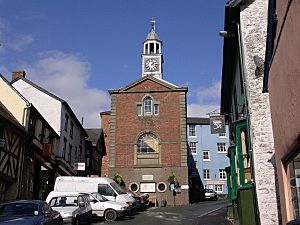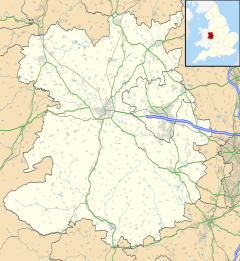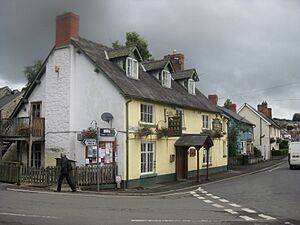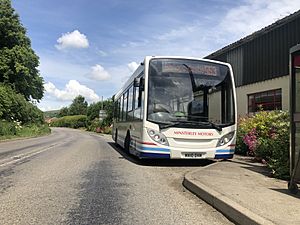Bishop's Castle facts for kids
Quick facts for kids Bishop's Castle
|
|
|---|---|
 Bishop's Castle Town Hall |
|
| Population | 1,893 |
| OS grid reference | SO323887 |
| Civil parish |
|
| Unitary authority |
|
| Ceremonial county | |
| Region | |
| Country | England |
| Sovereign state | United Kingdom |
| Post town | BISHOPS CASTLE |
| Postcode district | SY9 |
| Dialling code | 01588 |
| Police | West Mercia |
| Fire | Shropshire |
| Ambulance | West Midlands |
| EU Parliament | West Midlands |
| UK Parliament |
|
Bishop's Castle is a lively market town in the south west of Shropshire, England. In 2011, about 1,893 people lived there.
The town is located about 1.5 miles (2.4 km) east of the Wales–England border. It's about 20 miles (32 km) north-west of Ludlow and 20 miles (32 km) south-west of Shrewsbury. Bishop's Castle is in a farming area. It is also known for its creative community, including artists, musicians, writers, and craftspeople.
The area around Bishop's Castle is great for hillwalking. The town is a "Walkers are Welcome Town" since 2008. The Shropshire Way, a long walking path, goes through the town. Offa's Dyke, an ancient border, is only a few miles to the west.
The Kerry Ridgeway, an old Bronze Age route, starts from the town. The BC Ring, a challenging 60-mile (97 km) route around the town, was created in 2008. Bishop's Castle also has two micro-breweries. One of them, the Three Tuns Brewery, is the oldest brewery in the UK.
Contents
History of Bishop's Castle
The Castle's Story
The history of Bishop's Castle goes back to Saxon times. A man named Edwin Shakehead gave some of his land to the Bishop of Hereford. This was after he was cured of an illness at Saint Ethelbert's tomb. Later, in 1087, a Bishop of Hereford built a castle. It was a motte and bailey castle, meaning it had a mound (motte) with a tower and a walled courtyard (bailey). The castle was built to protect the church and village from the Welsh.
The castle was attacked many times. In 1263, John Fitzalan, Lord of Arundel, attacked it during a disagreement with the Bishop of Hereford. This caused a lot of damage to the castle. In the past, the castle and parish were partly in Wales and partly in England. This often led to disagreements over land.
In 1557, the castle was described as having many rooms and towers. It also had a stable, a dovecote, a garden, a forest, and a park. As the area became more peaceful, Bishop's Castle became known as a "rotten borough." This meant that even though it was a small town, it elected two members of parliament from 1585. This system was unfair because a few people could control the votes.
By 1618, the castle began to fall apart. In the 1700s, parts of it were removed to make a bowling green. Some historians believe that houses in Market Square and Castle Street were built on the old castle walls.
The Three Tuns Brewery started in 1642. It is the oldest licensed brewery in Britain. While some parts of the building are from the 17th century, the main building was built around 1888.
In 1719, the Castle Hotel was built where the old castle's courtyard used to be. It was built for James Brydges, who became the Duke of Chandos. He was very rich and known for gaining wealth from his jobs.
The Castle Hotel was later sold to Robert Clive, also known as 'Clive of India'. He became very wealthy during his time in India. The hotel stayed in his family for some time.
Wealthy landowners, like Lord Clive, used to spend a lot of money to buy votes. This was a common practice in some areas to get a seat in Parliament. In 1726, it was found that almost all voters for one candidate had been bribed. This unfair voting system ended with the Reform Act 1832. After this, Bishop's Castle no longer had its own members of parliament.
Today, only a 10-meter-long stone wall remains of the castle. It is 2 meters thick and 3 meters high. The Castle Hotel stands on the castle's original site. It was largely built using stones from the old castle.
The Town's Growth
The town's current layout shows that it originally had 46 plots of land for houses. These were separated by small lanes that are now Church Street, Union Street, and Station Street.
In 1249, the town received a special permission from the king. This allowed it to hold a weekly market and an annual fair. Both are still very popular today.
In the 17th century, the Bishop's Castle Town Hall was built. It served as a new center for town administration, a court, and a prison. It was updated with help from the Heritage Lottery Fund and reopened in 2014.
Bishop's Castle was officially a "municipal borough" in 1885. It lost this title in the 1960s. However, it still has a mayor and its special town symbols. It is now known as a "Quality Town Council."
On April 2, 1990, Bishop's Castle was near the center of a 5.1 magnitude earthquake. The earthquake was felt across much of England and Wales.
The town is also close to the beautiful Shropshire Hills Area of Outstanding Natural Beauty.
Town Government
From 1584 to 1832, Bishop's Castle was its own parliamentary area. It had two members of parliament. From 1885, it was part of the Ludlow area. In 2024, it became part of the South Shropshire area.
Today, Bishop's Castle is a civil parish. It has its own town council and a mayor. The town council's website was one of the first in the UK to share its meeting plans and notes online.
There is also an electoral ward called Bishop's Castle in the Shropshire Council. This area includes nearby villages and had a population of 3,728 in 2011.
Things to See and Do
Bishop's Castle has many shops and local businesses. You can find everything from clothes shops to banks. The town is known for its unique and special shops.
There are several public houses (pubs) in town. You can also find two micro-breweries: the yellow Six Bells Brewery and the Three Tuns Brewery. The town also has many restaurants, bed and breakfasts, and The Castle Hotel. This hotel is built on the site of the old bishop's castle.
Other interesting places to visit include the House on Crutches Museum of country life. There is also the Rail & Transport Museum. The old cattle market is in the center of town.
Many houses in Bishop's Castle are painted in bright colors like blue, pink, yellow, and green. The Wintles, a new neighborhood, has energy-efficient eco-houses built by Living Villages.
Education
Bishop's Castle has a high school called Bishop's Castle Community College. It teaches students aged 11 to 16. About 450 students from the town and nearby villages attend. The town also has a primary school and a nursery.
Media
Local news and TV shows are provided by BBC West Midlands and ITV Central. You can get TV signals from the local relay transmitter.
Local radio stations include BBC Radio Shropshire, Hits Radio Black Country & Shropshire, Greatest Hits Radio Black Country & Shropshire, and Capital North West and Wales.
The town is served by local newspapers like the Ludlow Advertiser, County Times, and Shropshire Star.
Sports
Local clubs in Bishop's Castle play various sports:
Cricket
The 1st XI cricket team plays in Division 2 of the Shropshire Cricket League. The club also plays friendly games on Sundays. They offer regular coaching sessions for young people, usually on Monday evenings. Cricket was first played here in 1841. The club officially started in 1896 at the Six Bells pub. They have played at the Manor Ground since 1946.
In 2011, the 1st XI team finished 4th, which was their highest ever finish. The club's social base is the Castle Hotel.
Football
Bishops Castle Town football club plays in the Montgomeryshire Amateur League. They were Division 1 Champions in 2017–18. Before that, they played in the Mercian Regional Football League Division One for six years. The club was formed in the 1880s.
After matches and for meetings, the club uses The Kings Head Public House. They play their home matches at the Community College ground.
Rugby
Bishop's Castle and Onny Valley Rugby Club started in the late 1970s. They played friendly games against teams from Mid-Wales and Shropshire. In the early 1990s, they joined the league structure. Now, they play in Midlands Division Fourth North.
Other Sports
- Women's Hockey
- Squash
- Tennis
Transport
Bishop's Castle has been on an important route for travelers for a very long time. However, the town was bypassed by Thomas Telford's main road in the 19th century. The old inns in town used to provide places for travelers to stay and stable their horses.
There isn't a main road that goes directly through the town. However, the A488 runs just east of the town. It goes from Shrewsbury to Clun and Knighton. The B4385 road goes around the town and connects with the A488.
Bishop's Castle used to have a railway, the Bishops Castle Railway, from 1865 to 1935. Parts of the old railway, like embankments, bridges, and stations, can still be seen today. The closest train station now is Broome on the Heart of Wales Line.
There is a bus service (route 553) that runs between Bishop's Castle and Shrewsbury. It operates on Mondays to Saturdays during the daytime. A local company called Minsterley Motors runs this service.
Notable People
Many interesting people have connections to Bishop's Castle:
- Oliver Mathews (c. 1520–c. 1618), a Welsh apothecary and historian, lived nearby.
- Richard Broughton (1542–1604), an English judge and politician, whose family owned land in the parish.
- Hugh Broughton (1549–1612), a Hebrew scholar and theologian, was born in Owlbury, Bishop's Castle.
- Richard Gifford (1725–1807), an English poet and clergyman, was born in Bishop's Castle.
- Sir Albert Howard (1873–1947), an English botanist and a pioneer of organic farming, was born here.
- Robin Legge (1862–1933), a chief music critic for The Daily Telegraph.
- Fuzz Townshend (born 1964), a British drummer, TV presenter, and mechanic, lives in Bishop's Castle.
- Matthew Green (born 1970), a Liberal Democrat politician, lived here before becoming an MP.
- Peter Postlethwaite (1946–2011), a famous actor, lived near Bishop's Castle later in his life.
- John Kirkpatrick (born 1947), a folk musician.
Sports People
- Richard More (1879–1936), an English cricketer who played for Oxford University and Middlesex.
- James Sharples (1890–1969), an English cricketer who played for Glamorgan.
See also
 In Spanish: Bishop's Castle para niños
In Spanish: Bishop's Castle para niños




